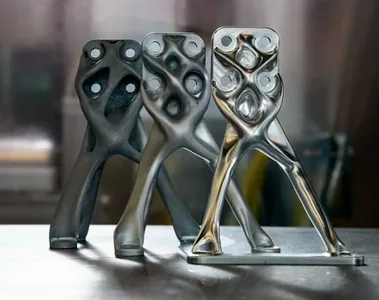AI-Designed Spacecraft Parts: Revolutionizing Space Exploration
NASA’s cutting-edge generative AI technology is redefining the future of aerospace engineering with AI-designed parts. An alien species seem to have left behind these AI-designed parts. These lightweight, highly durable, and efficient components result from the innovative Evolved Structures project led by Research Engineer Ryan McClelland at NASA’s Goddard Space Flight Center. People speculate that these parts are for space exploration, space telescopes, astrophysics balloon observatories, etc.

Source: Henry Dennis/NASA
How Generative AI Designs Alien-Like Structures With Unmatched Efficiency and Strength?
The generative AI process involves CAD specialists defining mission requirements and off-limits areas. It can produce complex structure designs in just a matter of hours. These designs are then vetted by human intuition to perfect and optimize them for real-world application. McClelland’s alien-like evolved structures save up to two-thirds of the weight compared to traditional components while withstanding higher structural loads.

Source: Henry Dennis/NASA
Revolutionizing Space Technology: How NASA’s AI-Designed Components Power the Most Complex Missions
Adopting NASA’s AI-designed components for various missions, including astrophysics balloon observatories, Earth-atmosphere scanners, planetary instruments, space weather monitors, space telescopes, and the Mars Sample Return mission. A prime example of this groundbreaking technology in action is the Exoplanet Climate Infrared Telescope (EXCITE) mission. Ryan McClelland’s AI-designed titanium scaffold for the EXCITE telescope solved complex design challenges. It solved challenges like connecting materials with differing thermal expansion properties without causing stress.

Also Read: DeBERTa V3: The Most Recent Member of DeBERTa Family of Generative AI Models
NASA’s AI and 3D Printing Integration Paves the Way for In-Space Manufacturing and Infrastructure Development

NASA’s unique need to create thousands of bespoke parts annually makes AI-assisted design an ideal solution for the organization. As additive manufacturing and 3D printing advance, it will be possible to build larger components and complex systems using in-situ resources in orbit, on the Moon, and even on Mars. By merging AI, 3D printing, and in-situ resource utilization, NASA and its commercial partners will drive the development of in-space servicing, assembly, and manufacturing capabilities, which are key priorities for the U.S. space infrastructure.
Revolutionizing Space Exploration With Generative AI: Shaping the Future of Aerospace Engineering

Source: Henry Dennis/NASA
NASA is embracing the power of generative AI and the incredible creativity it brings, and its alien-like designs are set to take us on an extraordinary journey through the stars. This will help push the boundaries of human ingenuity and space exploration. The future of aerospace engineering is now! Shaping AI-designed spacecraft parts that revolutionize how we explore the cosmos.
Also Read: DreamFusion Triumphs With Outstanding Paper Award: A Milestone in Text-to-3D Visualization







